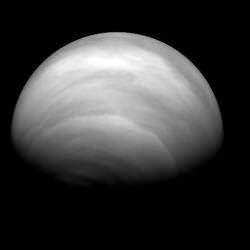As if the cloudy planet couldn’t get any more mysterious, Venus and its global weather patterns are baffling European Space Agency (ESA) scientists. The ESA Venus Express mission is continuing to unearth the details of what lies in and under its thick atmosphere, but Venus’s dynamic global weather patterns are very quick to consume the whole planet, like nothing we experience on Earth…
The ESA Venus Express missions Venus Monitoring Camera (VMC) is a long-term data gathering experiment to monitor the long-term progression of weather systems on the planet. On numerous occasions, the VMC has observed massive clouds of bright, hazy sulphuric acid particles form from equator to pole in a matter of days, only for it to disappear just as quickly. This suggests that fast dynamical, chemical and microphysical processes are at work on the planet in scales never before realized.
“This bright haze layer is made of sulphuric acid […] the process is a bit similar to what happens with urban smog over cities.” – Dmitri Titov, VMC Co-Investigator and Venus Express Science Coordinator, Max Planck Institute for Solar System Research, Germany.
With over 600 orbits completed, the VMC is observing the effects that solar radiation has on the dynamics of Venus’s atmosphere. It is well known that Venus’s atmosphere is carbon dioxide-rich and also contains water molecules and gaseous sulphur dioxide. Should this mix be exposed to UV radiation, the molecules will break up, forming a mix of highly reactive chemicals. As these chemicals bond, droplets of sulphuric acid form, creating planetary-scale clouds of bright haze. However, the planets atmosphere is too thick for much of the solar radiation to penetrate. For the gases to be exposed to UV radiation, some powerful atmospheric process must force them aloft, above much of the dense atmosphere, allowing them to react.
Although the bright haze of Venus’s atmosphere has been identified, many dark patches have also been observed. So far, there is no explanation for these patches of atmospheric chemicals absorbing solar UV, but the presence of the orbiting Venus Express is hoped to shine light on the dark and bright atmospheric features and how the atmosphere is mysteriously driving them.
Source: ESA


Sulphuric acid from CO2 and water – some really powerful atmospheric effects must be involed. If we shoot lead in there will it come out as gold?
Bruce, just read the post more carefully and it will all make sense ;).
“and also contains water molecules and gaseous sulphur dioxide.”